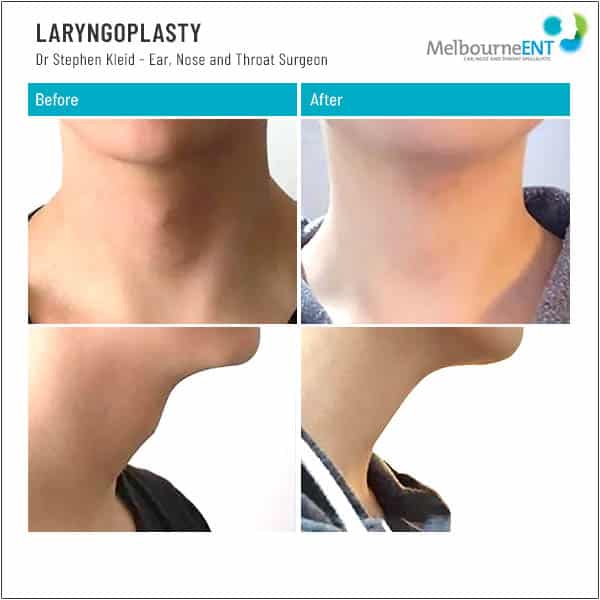The Adam’s apple, scientifically known as the laryngeal prominence, is a prominent structure in the neck that can vary in size and shape among individuals.
Adams Apple Reduction, also referred to as Chondrolaryngoplasty, tracheal shave or thyroid cartilage reduction is a surgical procedure designed to address the size or prominence of the Adam’s apple. While individuals may have different motivations for considering this procedure, understanding its intricacies is crucial for making an informed decision.
We understand that undergoing any surgical procedure is a significant decision, and it is essential to be well-informed. By exploring the comprehensive information provided below, you can gain a deeper understanding of Adams Apple Reduction and make an educated choice that aligns with your personal goals and aspirations.
What is the Adams Apple?
The Adam’s apple, also known as the laryngeal prominence, is a visible protrusion in the neck area that is more prominent in males than females. It is formed by the thyroid cartilage, which is part of the larynx or voice box. The primary function of the Adam’s apple is to protect the vocal cords and assist in voice modulation.
The size and prominence of the Adam’s apple can vary among individuals, and it is typically more prominent during puberty when the larynx undergoes growth and development. In males, the increase in size is more significant, resulting in a more visible Adam’s apple compared to females.
The Adam’s apple itself does not serve a vital physiological purpose however, for individuals who are uncomfortable with the size or appearance of their Adam’s apple, medical interventions such as Adams Apple Reduction surgery can be considered.

Adam’s Apple Reduction Before and After Gallery
See more of Dr Stephen Kleid’s previous nose surgery patients before and after surgery
Am I a good candidate for Adam’s apple reduction?

Adams Apple Reduction, is also known as MTF Adam’s apple surgery and is often sought by individuals undergoing male-to-female transition. However, it is important to note that this procedure is not exclusive to transgender individuals and can be pursued by anyone, (regardless of gender identity), who desires a reduction in the prominence of their Adam’s apple.
Good candidates for Adam’s apple reduction include both men and women who want to change the prominence of their Adam’s apple. This can be particularly relevant for individuals with long, thin necks, as the prominence may be more noticeable in such cases.
It is crucial for candidates to have a thorough understanding of the procedure and hold realistic expectations. They should be aware of the potential outcomes, risks, and limitations associated with Adams Apple Reduction.
Consulting with a qualified surgeon is essential to assess candidacy and discuss individual goals, ensuring that the procedure aligns with their expectations and desires.

The Procedure
During the procedure, you will be placed under general anesthesia. The surgeon will then make a small incision in the skin crease below the chin or in the natural crease above the Adam’s apple, depending on the technique chosen.
The two common techniques used for Adam’s apple reduction are the tracheal shave and thyroid cartilage resection.
Tracheal Shave
This technique is the most common approach for Adams Apple Reduction. It involves making a small horizontal incision in the natural crease just above the Adam’s apple. Through this incision, the surgeon will carefully access the thyroid cartilage and reduce its size by shaving or trimming the excess cartilage. The incision is then closed with sutures, and the scar is typically discreet and hidden within the natural contours of the neck.
Thyroid Cartilage Resection
In some cases, when a more significant reduction is required, the surgeon may opt for a more extensive procedure. This technique involves making an incision either horizontally or vertically along the midline of the neck to expose the thyroid cartilage. The surgeon will then remove a portion of the cartilage to reduce the prominence of the Adam’s apple. The incision is closed with sutures, and proper care is taken to ensure an aesthetically pleasing outcome.
The duration of the procedure typically ranges from 30 to 60 minutes, depending on the complexity and individual requirements. The incision sites are strategically chosen to minimize visible scarring, and the scars tend to be discreet. Additionally, the incisions are designed in a way that they do not adhere to the underlying cartilage, allowing for natural movement during speaking and swallowing.
It is essential to note that the choice of surgical technique may vary based on factors such as the patient’s anatomy, desired outcome, and the surgeon’s expertise. During a consultation, Dr Kleid will thoroughly assess your condition, discuss your goals, and recommend the most suitable technique to achieve optimal results while prioritizing your safety and satisfaction.
Recovery after Adams Apple Reduction
After the Adams Apple Reduction procedure, your safety and well-being are of utmost importance. Depending on the existent of the procedure, you may either stay overnight in the hospital or remain under observation for at least 8 hours, before you are able to go home. This allows Dr Kleid to closely monitor you for any signs of intra-laryngeal swelling or breathing difficulties, ensuring a safe recovery.
In terms of post-operative care, there are no specific restrictions or special instructions apart from keeping the dressing dry for the initial three days. Following this period, you can safely shower and allow the dressing to get wet without any concerns.
It’s important to note that this procedure does not typically result in a change in voice. However, some patients may experience mild gruffness for a few weeks, which is temporary and resolves over time.
In terms of discomfort, Adams Apple Reduction is generally well-tolerated, and the pain level is typically manageable (however, everyone experiences pain differently). You may experience some soreness while swallowing, which can be alleviated by consuming soft foods during the healing process.
One of the significant advantages of this procedure is that the results are visible almost immediately, even with the dressing in place.
Dr Kleid and his team will provide you with comprehensive post-operative care instructions and ensure that you have the necessary support and guidance throughout your recovery journey.
Risks and complications of Adam’s Apple Reduction
As with any surgical procedure, Adams Apple Reduction surgery carries potential risks and complications, although they are generally rare. It’s important to have a comprehensive understanding of these risks before making a decision. Some potential risks and complications associated with Adams Apple Reduction surgery include:
- Bleeding:
- There is a small risk of bleeding during or after the procedure. While uncommon, excessive bleeding may require further medical intervention.
- Infection:
- Although uncommon, there is a risk of infection at the surgical site.
- Proper preoperative preparation and postoperative care can help minimize this risk.
- Scarring:
- While efforts are made to minimize visible scarring, there is always a possibility of noticeable scarring, especially in individuals with a predisposition to abnormal scarring.
- Nerve damage:
- The surgery involves working around delicate nerves in the neck area, and there is a small risk of nerve damage, which could result in temporary or permanent changes in sensation or movement.
- Swelling and bruising:
- It is common to experience some degree of swelling and bruising after the surgery.
- This usually resolves over time but may take several weeks to subside completely.
- Asymmetry:
- In rare cases, there may be slight asymmetry or unevenness in the results.
- This can occur due to variations in healing or individual anatomical factors.
- Dissatisfaction with results:
- While Adams Apple Reduction surgery generally yields positive outcomes, there is a possibility of not achieving the desired results.
- It’s crucial to have realistic expectations and thorough communication with your surgeon to ensure mutual understanding of the expected outcome.
It’s important to note that these risks and complications are relatively rare, and the majority of individuals who undergo Adams Apple Reduction surgery experience successful outcomes with minimal complications. Dr Kleid will discuss these risks in detail during your consultation and take all necessary precautions to minimize the likelihood of complications and ensure a safe and satisfactory surgical experience.
What is the cost of Adams Apple Reduction?
The cost of Adams Apple Reduction surgery can vary depending on several factors, including the geographical location, the surgeon’s experience and expertise, the specific techniques used, the complexity of the procedure, and any additional fees associated with anesthesia, surgical facility, and post-operative care.
It is advisable to consult with a qualified surgeon who specializes in Adams Apple Reduction to get an accurate cost estimate tailored to your specific needs and circumstances. During your consultation, the surgeon will assess your individual case and provide you with a detailed breakdown of the expected costs involved in the procedure.
It’s also important to consider that health insurance coverage for Adams Apple Reduction surgery may vary. Some insurance plans may cover the procedure if it is deemed medically necessary, such as for individuals undergoing gender transition. It’s recommended to check with your insurance provider to understand the coverage and any associated requirements.
Ultimately, the cost of Adams Apple Reduction surgery should be weighed against the potential benefits and your personal goals for the procedure. It’s crucial to choose a qualified and experienced surgeon who prioritizes patient safety and satisfaction to ensure the best possible outcome.
Tracheal Shave / Adam’s Apple Reduction FAQ’s
How can I reduce my prominent Adam’s apple?
You can reduce Adam’s apple with Laryngoplasty – also called ‘tracheal shave surgery.’
Why do I have Adam’s apple if I’m a girl?
The truth is that males and females alike develop Adam’s apple, but it is more prominent in men. The increased prominence of Adam’s apple in men is due to a larger larynx that grows during male puberty, due to Testosterone. The vocal cords lengthen, the voice might “break’, and it becomes deeper.
Does the size of your Adam’s apple mean anything?
No. The size of Adam’s apple varies from one person to another. Bigger Adam’s apple simply means some people develop a larger voice box than others. Generally speaking, persons with a larger Adam’s apple tend to have a deeper voice. This explains why women usually don’t have as deep voice as men do.
Why is my Adam’s apple swollen?
Adam’s apple may appear swollen due to goitre i.e. an abnormal enlargement of the thyroid gland. Goitre is located in the neck, just below Adam’s apple. The most common symptoms of goitre are tension and tightness in the throat. Other symptoms may include difficulty breathing and/or swallowing and swelling in the front of the throat and neck. That’s why your Adam’s apple may seem swollen too.
Which portion of the larynx is Adam’s apple?
The thyroid cartilage is the portion of the larynx known as Adam’s apple. More precisely, the anterior portion of thyroid cartilage can be felt as this structure. It is a cartilaginous “shield” that protects the vocal cords.
What is the name of Adam’s apple?
The medical name for Adam’s apple is laryngeal prominence.
Can exercise worsen the sensation of nasal blockage caused by narrow nostrils?
Yes. During physical activity, your body needs more oxygen, and narrow nostrils may not allow sufficient airflow. This can lead to mouth breathing and reduced exercise comfort.
Sources:
- Correction of narrow nostril deformity secondary to cleft lip
Frontiers in Surgery (Shanghai Ninth People’s Hospital)
https://pmc.ncbi.nlm.nih.gov/articles/PMC10188927/ - Severe iatrogenic nostril stenosis
PubMed Central (PMC)
https://pmc.ncbi.nlm.nih.gov/articles/PMC4750266/ - Sling-bridge technique: new technique in extracorporeal septorhinoplasty
Frontiers in Surgery (University of Sulaimani, Tor Vergata University)
https://www.frontiersin.org/journals/surgery/articles/10.3389/fsurg.2024.1369067/full - Clinical effectiveness of septoplasty versus medical management for adults with nasal obstruction
The BMJ (British Medical Journal)
https://www.bmj.com/content/383/bmj-2023-075445 - Congenital bony nasal cavity stenosis: A review of current trends in diagnosis and management
International Journal of Pediatric Otorhinolaryngology
https://www.sciencedirect.com/science/article/abs/pii/S016558762100063X - Patient Satisfaction after Aesthetic Chondrolaryngoplasty – Plastic and Reconstructive Surgery Global Open
https://www.ncbi.nlm.nih.gov/pmc/articles/PMC6250475/ - Esthetic reduction of the thyroid cartilage: A systematic review of chondrolaryngoplasty – JPRAS Open
https://www.sciencedirect.com/science/article/pii/S2352587819300282
Further Reading
- Read more about Microlaryngoscopy Melbourne
- Read more about Throat Concerns and Conditions
- Read more about Palatoplasty Melbourne
- Read more about Adenotonsillectomy Melbourne
- Read more about Adenoidectomy Melbourne
Why Choose Dr Kleid ?

Dr Stephen Kleid,
Melbourne ENT Surgeon
MED0001052799
Dr Stephen Kleid is an experienced ENT Surgeon (Otolaryngologist) based in Melbourne with a passion for Septo-rhinoplasty, Septoplasty and a strong interest in Rhinoplasty Revision.
Qualifications
- AHPRA (Medical Board)
- MB, BS; FRACS (Fellow of the Royal Australasian College of Surgeons)
- AAFPS – Member of the Australasian Academy of Facial Plastic Surgery
- AAFPRS – (International Member of the American Academy of Facial Plastic and Reconstructive Surgeons)
Dr Kleid’s Procedures
Why Choose Dr Braham ?

Dr Simon Braham,
Melbourne ENT Surgeon
MED0001144757
Dr Simon Braham MBBS (Hons) FRACS is an experienced Ear, Nose and Throat ENT Surgeon (Otolaryngologist) based in Melbourne, performing tonsil, grommet and sinus surgery for children & adults. He helps patients with breathing issues, snoring concerns and sleep disturbances.
Dr Braham’s Procedures
How can we help?
The Melbourne ENT Team takes pleasure in assisting you with any questions when considering a plastic surgery procedure. Please call the St Kilda East clinic in Melbourne between 9am – 5 pm on Weekdays.
What Next?

Want more information about your Procedure?
- Please read our website and blogs to find out more about your procedure and concerns
- For more information about pricing and payment methods, please visit our page on Surgery Payment Options.
- Talk to our Patient Care Team from 9 am to 5 pm Monday to Friday

What to Bring to Your Consultation
- We encourage you to bring a friend or family member to accompany you, as they can provide an extra perspective and support throughout the process.
- It is important to take thorough notes and carefully review all the documents provided to you.

How to Book a Consultation
- A referral from your GP or Specialist is necessary to see a surgeon for a consultation.
- Dr Kleid’s Nose Surgery consultation fee is $600 which includes a nasendoscopy ($300).
- Please contact us to book your consultation.

